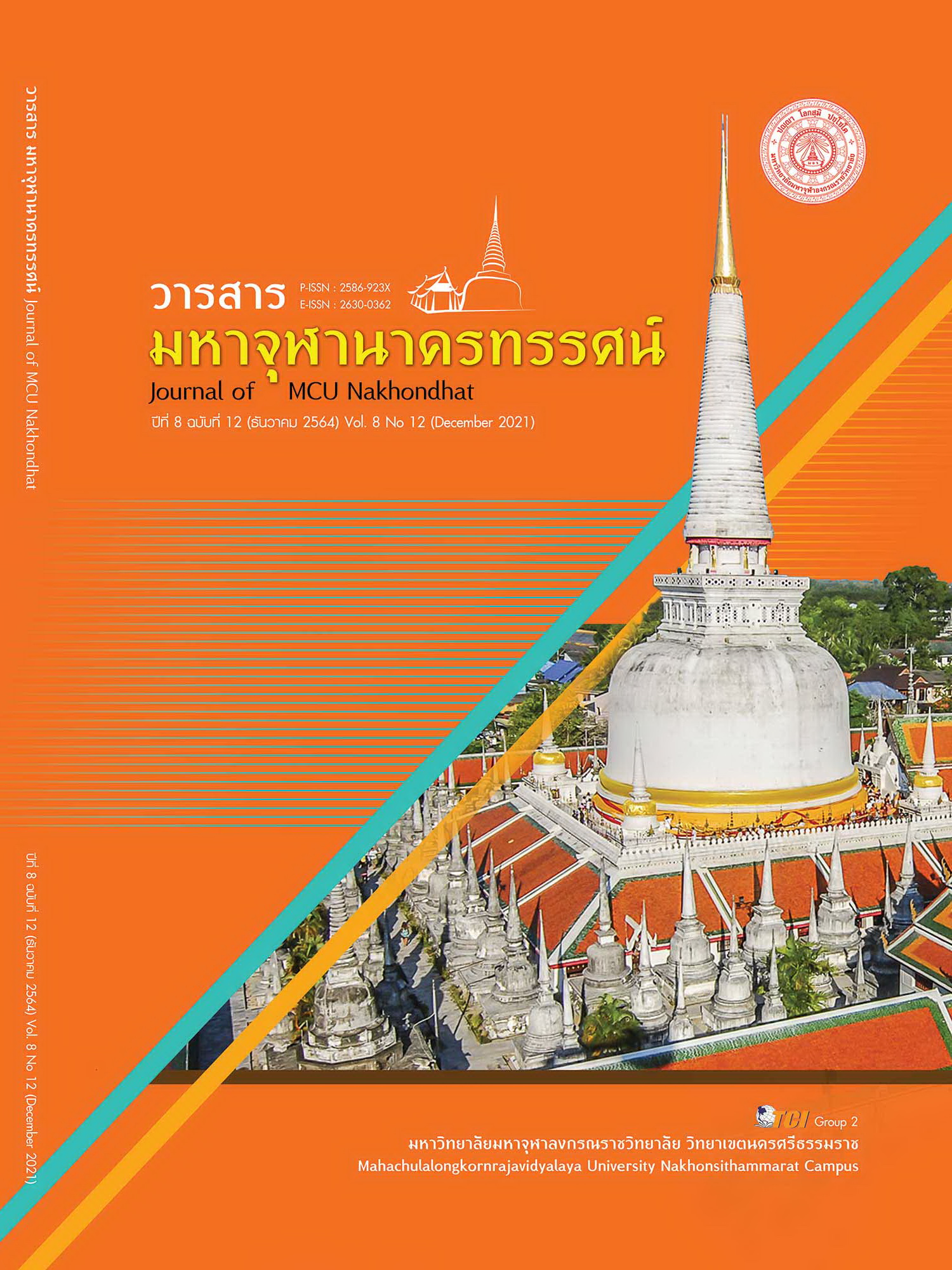MODEL OF TEACHING BY SITUATIONS BASE LEARNING OF NURSING STUDENT IN COVID-19 OUTBREAK
Main Article Content
Abstract
This article aims to study the satisfaction of the teaching model using Situations Base Learning of Nursing Student in the Covid-19 and comparing the Clinical judgement skill of nursing students before and after teaching model using Situations Base Learning. This is quasi-experimental research with a One group Pre-Posttest design. The population is 35 graduate nursing students in the 3rd year of the academic year 2020. The research instruments consisted of Situations Base Learning about pregnant women at antenatal care and pregnant women during delivery and satisfaction survey toward for teaching model using Situations Base Learning, then analyzed by mean, standard deviation, and t-test. The results show that the overall satisfaction score of the sample was at a high level ( = 4.80, S.D.=0.40). The score of Clinical judgement skill in post- test (M = 40.63, S.D. = 5.29) than pre -test (M =34.57, S.D. =4.64) of significantly (t = - 8.53, p < .000, dƒ = 34). The teaching model using Situations Base Learning about pregnant women at antenatal care and pregnant women during delivery. That could mean future readiness for practical training with patients. Therefore, the use Situations Base Learning in other courses should be encouraged in cases where practice with patients is not possible, such as during the COVID-19 outbreak. Along with lessons learned after using Situations Base Learning to develop.
Article Details
References
มูลนิธีคีนันแห่งเอเชีย. (2563). เราต้องช่วยเหลืออาสาสมัครสาธารณสุขในประเทศไทยเพื่อร่วมกันต่อสู้กับวิกฤตโควิด. เรียกใช้เมื่อ 25 ธันวาคม 2563 จาก https://www.kenan-asia.org/ th/thailand-health-volunteers-covid
รังสรรค์ มาระเพ็ญ. (2562). การพัฒนารูปแบบการจัดการเรียนรู้โดยใช้ผู้ป่วยจำลองในสถานการณ์เสมือนจริงในการศึกษาการ พยาบาลอนามัยชุมชน ของ รังสรรค์ มาระเพ็ญ. ใน ดุษฎีนิพนธ์ปรัชญาดุษฎีบัณฑิต สาขาวิชาพัฒนศึกษา. มหาวิทยาลัยศิลปากร.
วิทัศน์ ฝักเจริญผล และคณะ. (2563). ความพร้อมในการจัดการเรียนการสอนออนไลน์ภายใต้สถานการณ์ระบาดไวรัส Covid-19. ศาสตร์การศึกษาและการพัฒนามนุษย์, 4(1), 44-61.
ศุภลักษณ์ ธนาโรจน์และคณะ. (2562). การพัฒนาชุดการสอน เรื่อง การทำงานเป็นทีมการพยาบาล โดยใช้สถานการณ์จำลองเสมือนจริงสำหรับนักศึกษาพยาบาลศาสตรบัณฑิต. วารสารวิจัยและนวัตกรรมทางสุขภาพ, 2(1), 58-72.
สมจิตต์ สินธุชัยและคณะ. (2560). ผลของการจัดการเรียนรู้โดยสถานการณ์จำลองเสมือนจริงต่อความรู้ ความพึงพอใจและความมั่นใจในตนเองของนักศึกษาพยาบาลนปีที่ 4 ในการฝึกปฏิบัติรายวิชาฝึกทักษะทางวิชาชีพก่อนสำเร็จการศึกษา. รามาธิบดีพยาบาลสาร, 23(1), 113-127.
สายสมร เฉลยกิตติและคณะ. (2563). ผลกระทบโรคระบาด COVID-19: การจัดการเรียนการสอนทางการพยาบาล. วารสารวิจัยสุขภาพและการพยาบาล, 36(2), 255-263.
สำนักงานประชาสัมพันธ์จังหวัดราชบุรี. (2564). มาตรการเฝ้าระวังและควบคุมการแพร่ระบาดโรคติดเชื้อไวรัสโคโรนา 2019 (โควิด-19) ฉบับที่ 21 (คำสั่งที่ 454/2564) ลว. 30 มกราคม 2564. เรียกใช้เมื่อ 12 กุมภาพันธ์ 2564 จาก http://www.ratchaburi.go.th/rbcovid19/data/k454-21.pdf
สุดารัตน์ วุฒิศักดิ์ไพศาลและคณะ. (2563). ผลการใช้สถานการณ์จาลองเสมือนจริงในการเตรียมความพร้อมก่อนฝึกปฏิบัติงานต่อความรู้ความพึงพอใจและความมั่นใจในตนเองของนักศึกษาพยาบาล. วารสารวิจัยทางวิทยาศาสตร์สุขภาพ, 14(2), 70-80.
สุพรรณี กัณหดิลก และตรีชฎา ปุ่นสำเริง. (2559). การจัดการเรียนรู้โดยใช้สถานการณ์เสมือนจริง:การออกแบบการเรียนรู้ทางการพยาบาล. วารสารการพยาบาลและการศึกษา, 9(1), 1-14.
สุรชาติ สิทธิปกรณ์และคณะ. (2561). ผลของการจัดการเรียนรู้ด้วยหุ่นจำลองเสมือนจริงต่อความมั่นใจในตนเองและความพึงพอใจของนิสิตพยาบาลชั้นปีที่ 3 คณะพยาบาลศาสตร์ มหาวิทยาลัยมหาสารคาม. มหาสารคาม: มหาวิทยาลัยมหาสารคาม.
Best, J. & Kahn, J. V. (1993). Research in Education. (7th ed.). Boston: Allyn and Bacon.
Gaba, D. M. (2004). The future vision of simulation in health care. Quality Safety Health Care, 13(Suppl 1), i2-10.
Norman, J. (2012). Systematic review of the literature on simulation in nursing education. Association of black nursing faculty journal, 23(2), 24-28.
Partin J. L. et al. (2011). Students' perceptions of their learning experiences using high-fidelity simulation to teach concepts relative to obstetrics. Nursing education perspectives, 32(3), 186-8.
Wang A. L. & Fitzpatrick J. J. (2013). Effects of High-Fidelity Simulation Based Learning for Preparation of Practice on Knowledge, Satisfaction, and Self-Confidence of nursing students. JOURNAL OF HEALTH SCIENCE RESEARCH, 14(2), 70-81.
Yang, F. et al. (2019). Improving clinical judgment by simulation: A randomized trial and validation of the Lasater clinical judgment rubric in Chinese. BioMed Central Medical Education, 19(1), 20-30.


